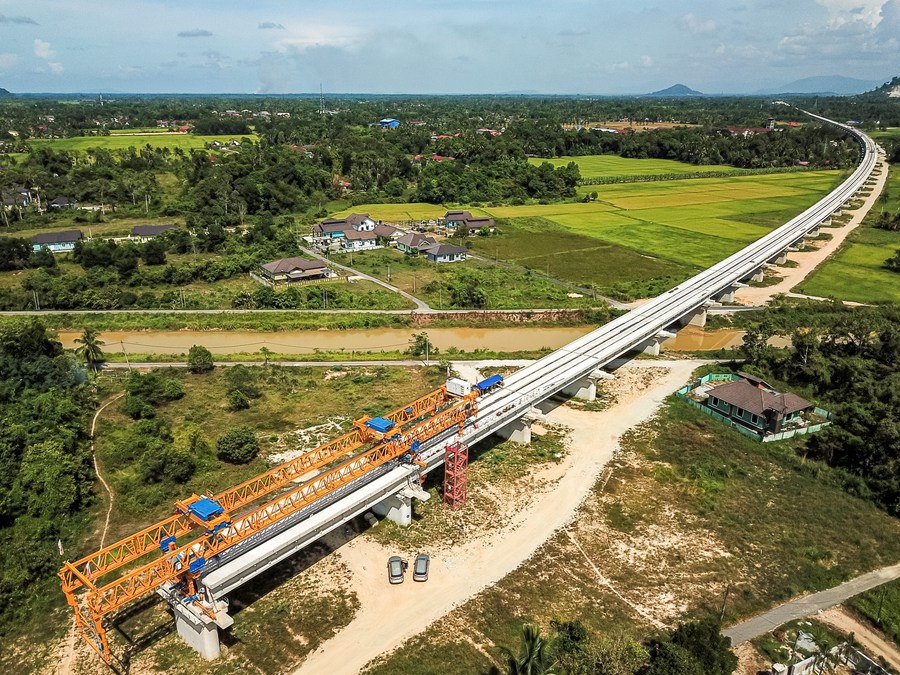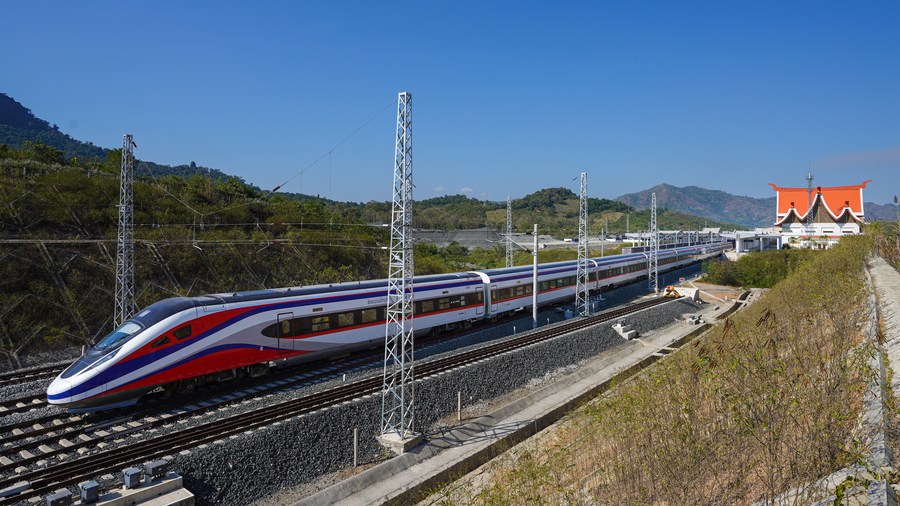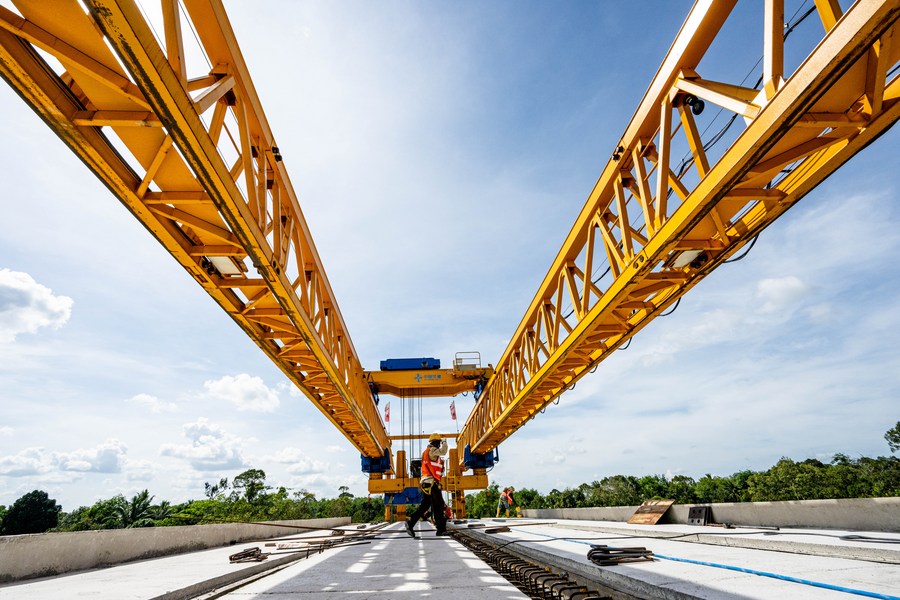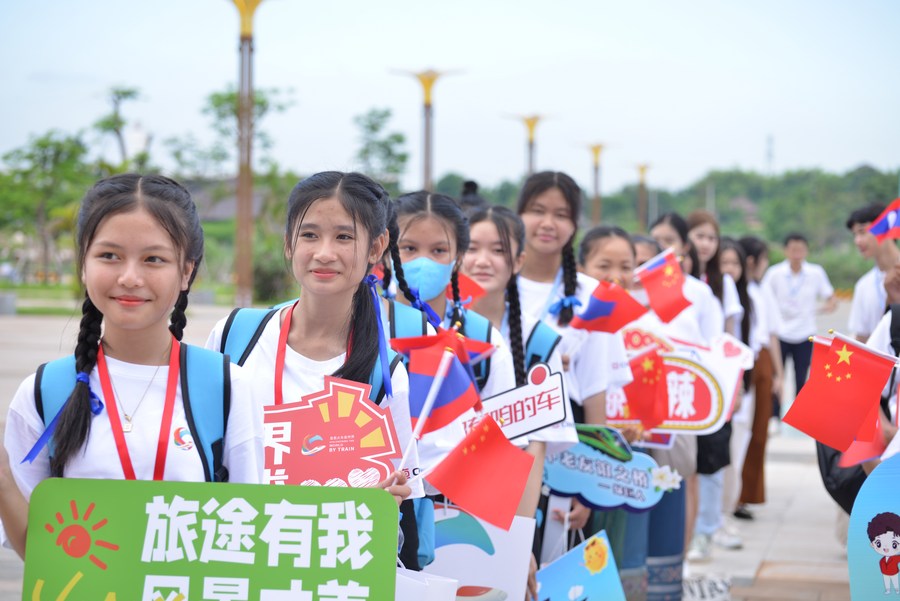BRI to herald new phase of int'l cooperation, says Malaysian expert

This aerial photo taken on April 26, 2023 shows a construction site of the East Coast Rail Link (ECRL), a major infrastructure project under the Belt and Road Initiative (BRI) in Kelantan, Malaysia. (Xinhua/Zhu Wei)
Ong Tee Keat, president of Belt and Road Initiative (BRI) Caucus for Asia Pacific, believed that the BRI is well positioned to embark on a new phase of high-quality development and more "small but beautiful" projects are likely to characterize the BRI turf.
KUALA LUMPUR, Oct. 24 (Xinhua) -- The third Belt and Road Forum for International Cooperation is all set to herald a new phase of international cooperation characterized by sustainable low carbon features, said Ong Tee Keat, president of Belt and Road Initiative (BRI) Caucus for Asia Pacific.
Infrastructure development is there to stay but is subject to a higher benchmark of sustainability. More "small but beautiful" sustainable projects are well positioned to bring new impetus to reshape the lifestyle and well-being of humanity across the globe, Ong told Xinhua in an interview after attending the forum in Beijing.
People connectivity through cultural mutual learning and interaction is gaining significance in its way forward, he added.

The Lane Xang passenger train of the China-Laos Railway runs past a maintenance center in Luang Prabang, Laos, March 30, 2023. (Photo by Zhou Xing/Xinhua)
Ong once served as the deputy speaker of Malaysia's lower house of parliament, Malaysian transport minister and president of the Malaysian Chinese Association.
Speaking of the features of the BRI, he pointed out that it is an inclusive endeavor of connectivity built on the principles of "extensive consultation, joint contribution and shared benefits."
"The projects are host-driven to meet the developmental demands in the host countries. In addition, no attached conditionalities are made pre-requisites for embarking on the BRI," Ong said, adding that as a public good offered by the Chinese, the BRI outreach could endear China to the host countries as it was not designed to antagonise any specific country for geopolitical purpose.
He said the BRI prioritizes connectivity in its outreach, notably physical connectivity through infrastructure development.

People work at a construction site of the East Coast Rail Link (ECRL), a major infrastructure project under the Belt and Road Initiative (BRI) in Kelantan, Malaysia, April 26, 2023. (Xinhua/Zhu Wei)
"Its huge capital outlay and construction roll-out have offset the existing infrastructure finance gap considerably," Ong explained.
The Silk Road Economic Belt and 21st Century Maritime Silk Road Initiative, proposed by China in 2013, aims to build an infrastructure and trade network that spans across the globe, linking Asia with Europe and Africa along the ancient Silk Road and beyond.
"A case in point is the China-Laos Railway, which has transformed Laos from a landlocked ASEAN member state to a land-linked country. The infrastructural connectivity has reshaped the entire logistical landscape of the Peninsular ASEAN, paving the way for the ultimate realization of the Pan-Asian Railway System."
Parallel to this, he said the physical connectivity has also been instrumental in rebalancing the economic inequality across the region. The East Coast Rail Link (ECRL), which is now underway in Malaysia, illustrates the argument well.
The once disrupted project, scheduled for completion by the end of 2027, is well poised to give the economic backwater in the east coast states of Peninsular Malaysia a new lease of life with the logistical connectivity to the more developed west coast.

Lao students prepare to board the EMU train of the China-Laos Railway in Vientiane, Laos, June 21, 2023. (Photo by Tamon Huengmeexay/Xinhua)
Speaking of the future development of the BRI, he believed that the initiative is well positioned to embark on a new phase of high-quality development, primarily in the sectors of digital and green economy.
More "small but beautiful" projects are likely to characterize the BRI turf, as the initiative ushers in the second decade. All these would contribute to transforming the lifestyle of many societies in the interest of humanity, he said.
Ong emphasized the importance of sharing more BRI stories that can touch the hearts and minds of the people outside China and the need for capacity building through technology collaboration in pursuing digital and green economies.
"Given that its BRI partners from the developing Global South, too, are in dire need of homegrown innovation, but are mostly strait-jacketed by their scarcity of funds and inadequate technology know-how, China's technological empowerment through cooperation makes an ideal choice to fill the void," he said.


